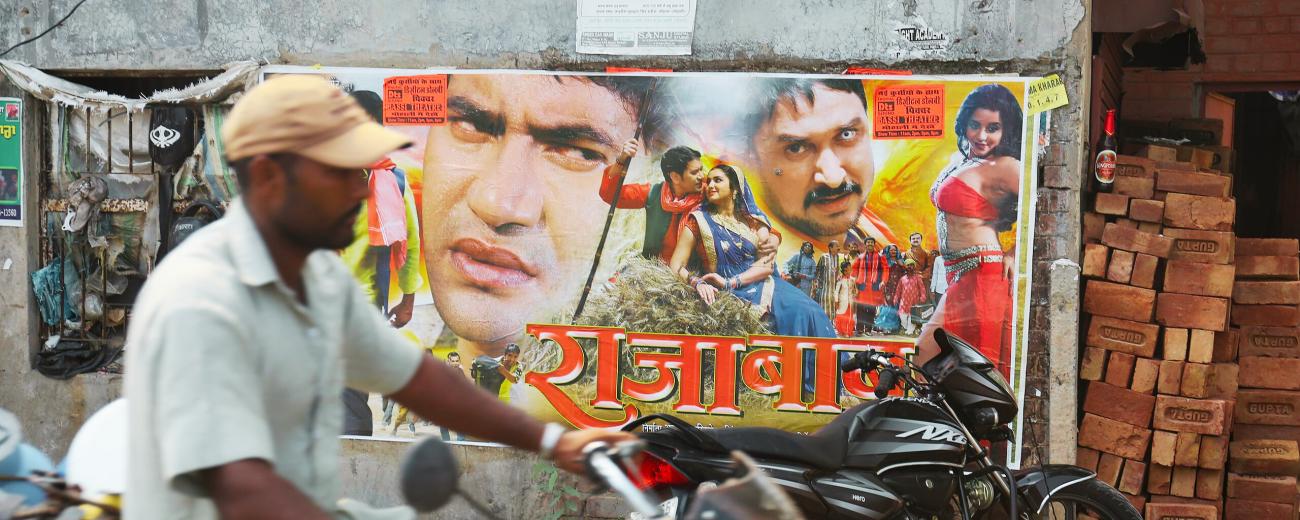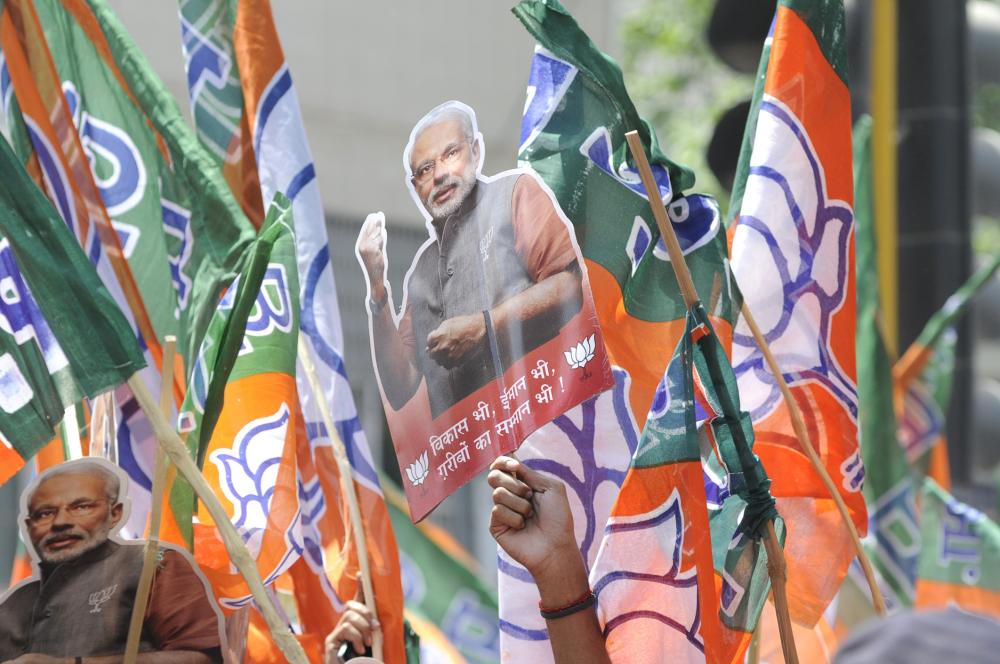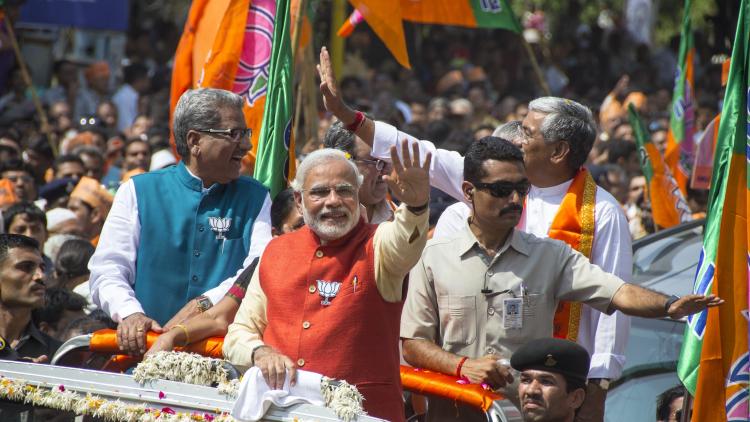Saffronizing Bollywood: How India’s Hindu right is controlling its prolific Hindi film industry


The Bollywood industry is decentralised and commercially driven, so how has it been influenced by Hindu nationalist politics? For his MA dissertation at SOAS, Kaashif Hajee conducted fieldwork and interviewed prominent Bollywood figures to find out.
Ahead of India’s national elections, a slew of brazenly Hindu nationalist propaganda films have been swamping the country’s voters. It is the outcome of the Hindu Right –– the ruling Bharatiya Janata Party (BJP) and a family of Hindutva organizations under the Rashtriya Swayamsevak Sangh (RSS) –– steadily saffronizing India’s Hindi film industry, colloquially known as Bollywood. As India’s most prolific and powerful media industry, Bollywood is a key source of soft power and plays a crucial role in defining dominant conceptions of nationhood, belonging, and culture.
This was the subject of my dissertation in MA Social Anthropology, for which I conducted three months of fieldwork in Mumbai in the Summer of 2023 and interviewed prominent writers, directors, producers, actors, and journalists of Bollywood.
Understanding Hindutva
The ideology of Hindu nationalism, or Hindutva, conceives India as a Hindu nation, relegating Muslims and other minorities to second-class status. Historically, its ideologues drew inspiration from German Nazism and Italian fascism, while its closest ideological counterpart today is Israeli Zionism. Independently governing India since 2014 under Prime Minister Narendra Modi, the BJP has used a carrot-and-stick strategy to control and regulate Bollywood’s influence: a combination of bullying and promoting films that most vociferously echo their ideology.
Bollywood is a key source of soft power and plays a crucial role in defining dominant conceptions of nationhood, belonging, and culture.
Yet for the most part, members of Bollywood have continued to see themselves as apolitical. The Bollywood industry is highly decentralised, commercially driven, and blockbuster-oriented. Politics is peripheral to the eternal quest for the elusive box office hit. Then how has the BJP succeeded so profoundly?
Fear and censorship
Alongside its elaborate army of online trolls, the BJP has also incited mobs, engineered police cases, and orchestrated arbitrary arrests. This has successfully stoked fear and created a pervading atmosphere of censorship in the industry.
“You don't just deal with these issues when your film or your show is coming out,” one writer-director-producer said to me. “You're dealing with them while you are writing. There is a psychological aspect to it.” Many key Bollywood members shared how their creative process now includes several additional considerations, like avoiding depicting green and saffron colours and any religious symbols and erasing any critiques of the police or politicians.
This was not the case before even 2020. A screenwriter named it the “chilling effect” – a perpetual state of cowering invoked in the face of the BJP’s “bullying tactics.” “You just have to stay in line,” he reflected, “ That builds a self-censorship inside you.”
The new blockbuster
While the BJP suppresses, it also amplifies. The party’s vigorous promotion of The Kashmir Files (2022) and The Kerala Story (2023), for instance, has created a replicable template for a new kind of unabashedly bigoted blockbuster.
The Kashmir Files claims to depict the 1990 Kashmiri Pandit (Hindu) exodus, but through crucial omissions, creates a dangerously one-sided representation of Muslim violence against Hindus. The Kerala Story, meanwhile, claims to tell a deadly “true story” of 32,000 Hindu girls from Kerala who’ve been recruited to ISIS, which is demonstrably false, and cherry-picks disparate cases to peddle the Hindu nationalist “Love Jihad” conspiracy theory. Simplistic and unsubtle, both films use shock value to incite Hindus towards collective anger, humiliation, and anti-Muslim hatred.
These films were personally, profusely praised by Prime Minister Modi and other BJP leaders, promoted by the “Godi” (or “lapdog”) news channels sympathetic to the ruling party, and bestowed the coveted tax-free status in several exclusively BJP-ruled states. Consequently, both films earned roughly 10 times their budget at the domestic box office alone, making them bona fide blockbusters.
Since the 1950s, the scholar Priya Joshi argues, Bollywood blockbusters have “captured dispersed anxieties and aspirations about the nation.” As India’s new blockbusters, The Kashmir Files and The Kerala Story reflect a nation engulfed in Islamophobia and Hindutva rhetoric.
Riding the saffron wave
While it may be tempting to exceptionalize these films, they are only more extreme, brazen versions of an increasingly ubiquitous trend. From historical fiction films about Islamic invaders to cop and war films about fighting Islamic terrorism and Pakistan, Hindutva themes are dominating India’s cultural production and national consciousness.
The hard ubiquity of these protecting-the-nation-state-narratives and the pervasive uber–Hindu-patriotism at their core reflects what scholars Edward Anderson and Arkotong Longkumer refer to as the mainstreaming of Hindu nationalism. By making Indian-ness synonymous with Hindu-ness, they normalise Islamophobia in public discourse.
By making Indian-ness synonymous with Hindu-ness, they normalise Islamophobia in public discourse.
There is now a lineup of propaganda films that peddle Hindutva conspiracies, celebrate Hindutva figures, and glorify the BJP while vilifying all its opponents: the Congress, academic institutions, activists, and, of course, Muslims. These films share similar conventions: no A-list stars, lower budgets, saffron-coloured text in their trailers and posters, sensationalist hashtags hinting at conspiracies, and a neo-realist-style colour grade. But more importantly, they all seek to recreate the template created by The Kashmir Files and The Kerala Story.
The BJP has thus harnessed the uncertainty endemic to the film industry to push it to perpetuate its Hindutva ideology. They are ultimately succeeding at saffronizing Bollywood, not by turning its largely apolitical members into Hindu nationalists, but by influencing market forces to make Hindutva stories more profitable and marginalising dissenting or “deviant” voices.
This new political order is increasingly being internalised, naturalised, and taken for granted by industry members, who appear, from my research, all too willing to compromise on their ideals for commercial success.
This blog is excerpted from an essay for South Asian Avant Garde (SAAG) Anthology, which was based on Kaashif’s Master’s dissertation titled “Saffronizing Bollywood: Weaponizing Uncertainty, Stoking Fear, and Creating a New Blockbuster.” The views and opinions expressed in SOAS Blogs are solely those of the respective authors and do not necessarily reflect the views of the organisation or act as an endorsement.
Image credit: Wikipedia Commons.
About the author
Kaashif Hajee was born and raised in Mumbai, India, where Bollywood was a core presence in his life. He studied sociology at NYU Abu Dhabi, where he later worked as a research assistant in the social science department, before completing his Master's in Social Anthropology at SOAS.
Kaashif currently writes about film and politics and works as a Film and TV Features Writer at Screen Rant. His words have also been published in The Quint, The Caravan, and South Asian Avant Garde Anthology. Follow him on Instagram, X and LinkedIn.



